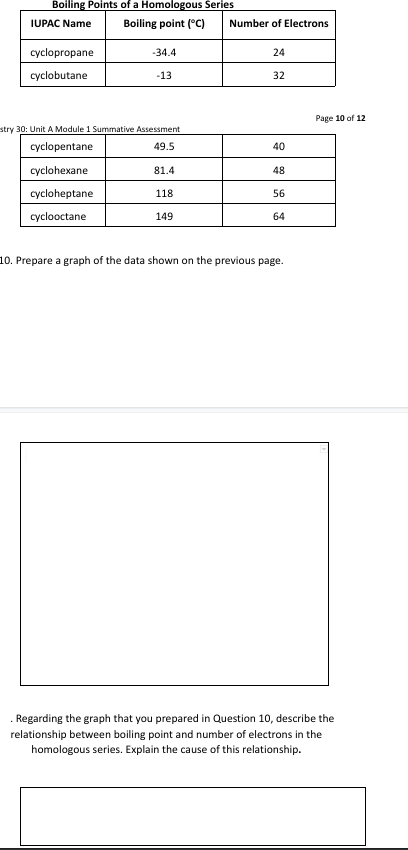Boiling Points of a Homologous Series Boiling point (°C) IUPAC Name cyclopropane cyclobutane -34.4 -13 stry 30: Unit A Module 1 Summative Assessment cyclopentane 49.5 cyclohexane cycloheptane cyclooctane 81.4 118 149 Number of Electrons 24 32 40 48 56 64 10. Prepare a graph of the data shown on the previous page. Page 10 of 12 Regarding the graph that you prepared in Question 10, describe the relationship between boiling point and number of electrons in the homologous series. Explain the cause of this relationship.
Boiling Points of a Homologous Series Boiling point (°C) IUPAC Name cyclopropane cyclobutane -34.4 -13 stry 30: Unit A Module 1 Summative Assessment cyclopentane 49.5 cyclohexane cycloheptane cyclooctane 81.4 118 149 Number of Electrons 24 32 40 48 56 64 10. Prepare a graph of the data shown on the previous page. Page 10 of 12 Regarding the graph that you prepared in Question 10, describe the relationship between boiling point and number of electrons in the homologous series. Explain the cause of this relationship.
Chemistry
10th Edition
ISBN:9781305957404
Author:Steven S. Zumdahl, Susan A. Zumdahl, Donald J. DeCoste
Publisher:Steven S. Zumdahl, Susan A. Zumdahl, Donald J. DeCoste
Chapter1: Chemical Foundations
Section: Chapter Questions
Problem 1RQ: Define and explain the differences between the following terms. a. law and theory b. theory and...
Related questions
Question

Transcribed Image Text:Boiling Points of a Homologous Series
Boiling point (°C)
IUPAC Name
cyclopropane
cyclobutane
-34.4
-13
stry 30: Unit A Module 1 Summative Assessment
cyclopentane
49.5
cyclohexane
cycloheptane
cyclooctane
81.4
118
149
Number of Electrons
24
32
40
48
56
64
10. Prepare a graph of the data shown on the previous page.
Page 10 of 12
Regarding the graph that you prepared in Question 10, describe the
relationship between boiling point and number of electrons in the
homologous series. Explain the cause of this relationship.
Expert Solution
This question has been solved!
Explore an expertly crafted, step-by-step solution for a thorough understanding of key concepts.
This is a popular solution!
Trending now
This is a popular solution!
Step by step
Solved in 3 steps with 2 images

Knowledge Booster
Learn more about
Need a deep-dive on the concept behind this application? Look no further. Learn more about this topic, chemistry and related others by exploring similar questions and additional content below.Recommended textbooks for you

Chemistry
Chemistry
ISBN:
9781305957404
Author:
Steven S. Zumdahl, Susan A. Zumdahl, Donald J. DeCoste
Publisher:
Cengage Learning

Chemistry
Chemistry
ISBN:
9781259911156
Author:
Raymond Chang Dr., Jason Overby Professor
Publisher:
McGraw-Hill Education

Principles of Instrumental Analysis
Chemistry
ISBN:
9781305577213
Author:
Douglas A. Skoog, F. James Holler, Stanley R. Crouch
Publisher:
Cengage Learning

Chemistry
Chemistry
ISBN:
9781305957404
Author:
Steven S. Zumdahl, Susan A. Zumdahl, Donald J. DeCoste
Publisher:
Cengage Learning

Chemistry
Chemistry
ISBN:
9781259911156
Author:
Raymond Chang Dr., Jason Overby Professor
Publisher:
McGraw-Hill Education

Principles of Instrumental Analysis
Chemistry
ISBN:
9781305577213
Author:
Douglas A. Skoog, F. James Holler, Stanley R. Crouch
Publisher:
Cengage Learning

Organic Chemistry
Chemistry
ISBN:
9780078021558
Author:
Janice Gorzynski Smith Dr.
Publisher:
McGraw-Hill Education

Chemistry: Principles and Reactions
Chemistry
ISBN:
9781305079373
Author:
William L. Masterton, Cecile N. Hurley
Publisher:
Cengage Learning

Elementary Principles of Chemical Processes, Bind…
Chemistry
ISBN:
9781118431221
Author:
Richard M. Felder, Ronald W. Rousseau, Lisa G. Bullard
Publisher:
WILEY